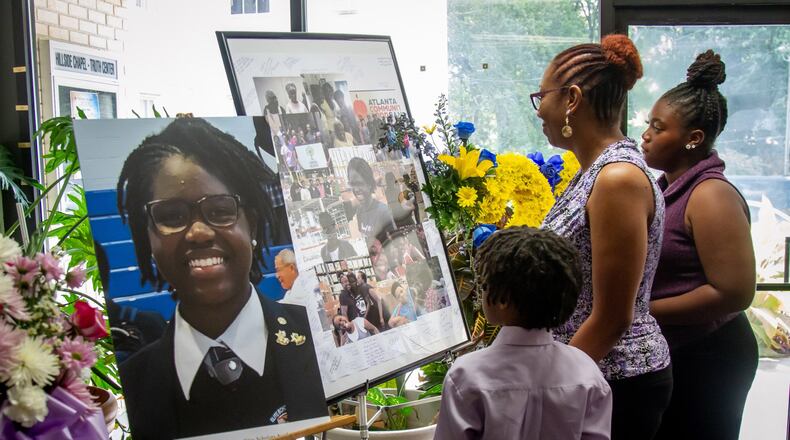Imani Bell died from heat stroke, according to an autopsy performed by the Georgia Bureau of Investigation.
The 16-year-old, who collapsed in August during an outdoor basketball team practice, died from hyperthermia and rhabdomyolysis, the report says.
Hyperthermia, as defined by the National Institutes of Health, is an abnormally high body temperature caused by a failure of the heat-regulating mechanisms of the body to deal with the heat coming from the environment. The NIH defines rhabdomyolysis as a complex medical condition involving the rapid dissolution of damaged or injured skeletal muscle.
Here is the text of the narrative summary from the official report of GBI Associate Medical Examiner Keith Lehman, dated Dec. 12, 2019. The autopsy was performed Aug. 15.
The following information was obtained from sources including Sergeant Ernest Mitchell of Clayton County Public Schools and from review of records including medical records, DFACS report, and investigative reports from Clayton Co. School Police and from The Young Group.
Ms. Bell was participating in conditioning training with approximately 7 other female student athletes of the Elite Scholars Girls’ Basketball team. The day of the incident (8/13/2019) was the first day of conditioning. Around 4:15 p.m. to 4:30 p.m., the female basketball players exited the gym to go condition outside. Conditioning started after 4:40 p.m. and included running one mile (four laps around the track) and followed by exercises including side by side foot shuffle exercises on the adjacent grass field. It rained for a short period of time during the conditioning. The basketball coach, a lay coach and a parent volunteer were outside at the time of the incident with the students. The players had access to water during the exercises, and had water squirted onto their backs.
The players were told to run up the hill, perform jumping jacks and then come back down the hill. Ms. Bell was lagging behind during the hill exercises, at which time one of the coaches was encouraging her and providing her water. At some point she was asked by an adult if she was ok, and Ms. Bell replied “yeah I’m good.” The players ran one lap (quarter mile) around the track and then were instructed to run the steps (located at the concession area of the track). Miss Bell attempted to run with the girls for the last lap but was unable and did a fast paced walk. One of the coaches noticed Miss Bell was tired, so he started walking the last lap with her and encouraged her.
The coaches believed Miss Bell was struggling a bit because she was out of shape. Miss Bell said it had been a while since she had last worked out, and it was not out of the ordinary for her to start the season out of shape. Upon arrival to the stairs, Ms. Bell did not run the stairs like the other girls but walked them. A coach was with her, encouraged her, and may have physically assisted her up the stairs. As Ms. Bell neared the top of the stairs, she was pulling her body up by the rail on the stairs, then she stopped to gather herself, leaned into the rail and then went limp/fainted on the stairs. The adults began to pour ice water on her at the steps after she went down, and Ms. Bell did not respond.
She was unresponsive, incoherent, breathing, her eyes were partly open, and she tried to pull herself up by grabbing the railing. She continued to be unresponsive and was moaning, and the ambulance was called. The incident occurred a short time before 5:54 p.m. Ms. Bell was brought inside to a hallway in the gymnasium at 5:55 p.m., and paramedics arrived at 5:56 p.m. This entire time, Ms. Bell was still breathing but would not respond to questions.
EMS was called and arrived (arrival time 6:00 p.m.) to find the decedent responsive by groans to painful stimuli, tachycardic with a weak carotid pulse, tachypneic, and diaphoretic with skin excessively warm to the touch. Blood glucose was 155. The decedent was placed in the ambulance at which time she became pulseless and apneic. CPR was initiated, and the decedent received fluids (~500 cc normal saline in route to hospital) and was intubated. She initially exhibited PEA and eventually had return of spontaneous circulation. Arrival time at the hospital was 6:28 p.m. Initial evaluation there included body temperature 101.7 F (rectal temperature at 6:33 p.m.), pulse 100, and blood pressure 141/115. Ice packs were applied upon initial evaluation. Body temperature at 7:37 p.m. was 101.1 F (axillary). She eventually went into cardiac arrest again and CPR was initiated. She had at least two episodes of return of spontaneous circulation. She was pronounced dead at 8:23 p.m. Her diagnoses included hyperthermia, acute renal failure, and rhabdomyolysis.
The decedent was observed in school on the day of the incident and appeared to be in a healthy state described as “her normal playful self.” She had no significant medical history. Per the decedent’s mother, the decedent had no history of heart arrythmias, episodes of heart racing, or unexplained episodes of syncope or shortness of breath.
Outdoor temperature between 4:30 p.m. and 6 p.m. on 8/13/19 (day of the incident) near Jonesboro, Ga. (site of the incident) ranged from 97 F to 92 F, humidity 40-55%, heat index ~101-103, and wind speed 7-15 m.p.h.
CAUSE OF DEATH: Hyperthermia and rhabdomyolysis during physical exertion with high ambient temperature.
MANNER OF DEATH: Accident.
About the Author
Keep Reading
The Latest
Featured


